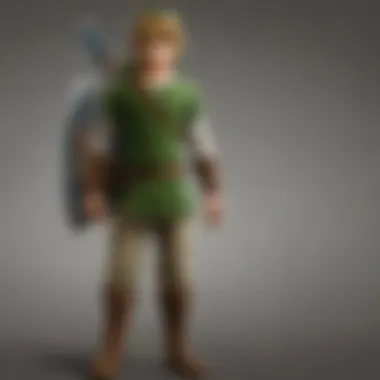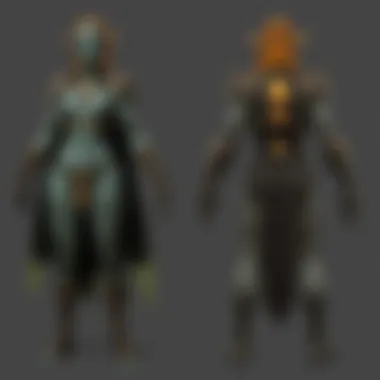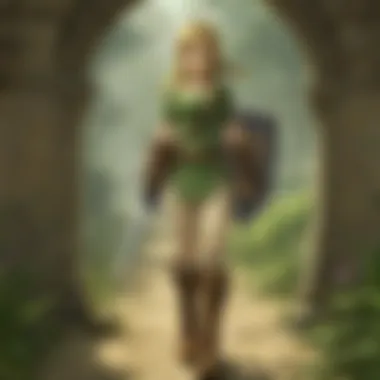A Deep Dive into The Legend of Zelda: Twilight Princess


Intro
The Legend of Zelda: Twilight Princess stands as a notable entry in the iconic franchise. Released originally for the GameCube and Wii in 2006, it marked a shift in design philosophy and narrative depth compared to its predecessors. This game challenges players with intricate puzzles and rich storytelling, creating an immersive experience.
The significance of Twilight Princess within the Zelda franchise cannot be understated. It explores darker themes and complex character arcs that resonate with both returning players and newcomers. With its expansive world, engaging gameplay mechanics, and unique artistic direction, Twilight Princess has captivated fans and influenced a broader gaming landscape.
This article aims to dissect various aspects of Twilight Princess, from gameplay to character development. Each section will unfurl the game’s layers, shedding light on its legacy and the cultural contexts surrounding its creation.
Prologue to Twilight Princess
The introduction to The Legend of Zelda: Twilight Princess serves as an essential framework that sets the stage for understanding the game’s complexity. It lays a foundation for examining not only the narrative depth but also the mechanics, character development, and thematic elements intrinsic to the experience. Understanding the context in which Twilight Princess was created enhances appreciation and offers insights into the decisions made by its developers.
Overview
Twilight Princess was released in 2006 for both the GameCube and Wii platforms. This title represents a pivotal point in the Zelda franchise, marked by its darker tone compared to its predecessors. The game's world is rich and diverse, filled with expansive landscapes, intricate dungeons, and unique characters. Crucial to the player’s journey is the duality of Link’s existence as both a human and a wolf, which introduces a novel approach to gameplay.
The narrative unfolds through various regions such as Hyrule and the Twilight Realm, creating an immersive experience that resonates with a broad audience. Engagement with the environment often requires strategic thinking and problem-solving, enriching the gameplay mechanics beyond simple exploration.
Significance in the Zelda Series
Twilight Princess holds a special place within the Zelda series due to its ambitious scope and the way it redefined gameplay conventions. It marked a notable departure from the bright and whimsical aesthetics of earlier titles. Instead, it embraced a more mature narrative and visuals that reflected a blend of hope and despair.
The game is often viewed as a bridge between classic Zelda elements and new innovations. It introduces new gameplay mechanics, including wolf transformation, which allows for different styles of interaction and puzzle-solving. The character of Midna, a pivotal companion, showcases a dynamic relationship with Link, presenting themes of trust and sacrifice.
This title not only appealed to veteran fans but also attracted a new generation of players, solidifying the series' relevance in the gaming landscape. The highs and lows experienced throughout the narrative echo in the hearts of many players, underscoring the game's lasting impact.
"Twilight Princess is remembered as a definitive entry in the series, one that brings depth and emotional weight to the Zelda franchise, captivating both new and returning players."
Narrative Structure
In any storytelling medium, the narrative structure is a crucial framework that shapes the audience's understanding of the plot and characters. In The Legend of Zelda: Twilight Princess, this structure enhances the depth and engagement of the game, facilitating an immersive experience for players. The game is known for its complex narrative, combining various elements such as character development, world-building, and thematic conflicts. These layers work together to create a compelling and resonant story.
Some key benefits of a well-structured narrative include:
- Clarity: Players can grasp the storyline's progression and motivations behind characters' actions.
- Emotional Impact: Well-crafted narratives evoke empathy and investment in characters’ journeys.
- Thematic Exploration: A clearly defined structure allows for meaningful themes to emerge, enriching the gameplay experience.
Plot Summary
Twilight Princess takes place in a twilight-infested land called Hyrule. The story begins with Link, a young rancher, who is summoned to aid Princess Zelda. As darkness engulfs the land, Link transforms into a wolf, with the help of Midna, a mysterious creature from the Twilight Realm. Together, they navigate various dungeons and face the antagonist, Zant, who usurps control over Hyrule and seeks to plunge it into eternal twilight.
The plot intricately weaves elements of heroism, sacrifice, and the struggle between light and dark. As Link progresses in his quest, he uncovers deeper layers of his own identity and the burdens that come with it. The story culminates in a final confrontation where the themes of light and courage shine most brightly.
Character Arcs
Link


Link is the protagonist of the game and embodies the archetype of the reluctant hero. His journey starts from a simple rancher to the savior of Hyrule. This evolution holds significant weight in the narrative. One key characteristic of Link is his resilience in the face of adversity. He discovers his destiny through trials that require courage and growth.
Link's unique feature is his ability to shift between his human form and a wolf. This transformation not only adds a layer of gameplay mechanics but also symbolizes his internal struggle. The advantages of this duality enhance his character arc, as players experience different forms of power and vulnerability.
Princess Zelda
Princess Zelda's role involves much more than being a damsel in distress. She is a powerful figure tied to Hyrule's fate. One key aspect of her character is her wisdom and strength. Unlike previous iterations, this version presents Zelda as deeply involved in the narrative's conflict.
Zelda possesses unique abilities that play a vital role in the unfolding of the story. Her presence in the narrative evokes themes of sacrifice and leadership, making her a pivotal character. The strengths of her character display complexity that enriches the overall narrative depth.
Midna
Midna represents the embodiment of both assistance and conflict. Initially, she appears self-serving, but her character arc unfolds to reveal layers of depth and emotional connectivity. A key characteristic of Midna is her cunning nature; she often guides Link with a blend of sarcasm and insight.
Midna's unique feature lies in her ability to manipulate shadows and perform powerful spells. These traits allow for strategic gameplay elements, impacting how players approach challenges. Her transformation also serves as a narrative revelation, bringing forth emotional weight that impacts the story’s resolution.
"Characters in Twilight Princess are not just vessels for gameplay; they are integral to the story's emotional resonance and depth."
Through these character arcs, the narrative structure of Twilight Princess becomes a rich and layered tapestry that captivates players, inviting them to delve deeper into the themes of the game.
Game Mechanics
The mechanics of a game define how players interact with it. In the context of The Legend of Zelda: Twilight Princess, these mechanics play a vital role in enhancing the player experience. They provide seamless integration between gameplay and storytelling, making every action feel significant. A well-designed mechanic can create a bond between the player and the character, providing satisfaction and motivation. The game mechanics are crucial, as they allow players to navigate through challenges, experience growth, and immerse themselves in the rich world of Hyrule.
Combat System
Combat in Twilight Princess is diverse and engaging. The game utilizes a blend of traditional hack-and-slash elements with strategic combat. Players control Link as he battles various foes, ranging from Goblins to powerful bosses. One of the key features of the combat system is the Z-targeting mechanic. This allows players to lock onto enemies for improved precision during fights. This feature is especially beneficial in multi-enemy encounters, as it simplifies aiming and evading attacks.
Additionally, the game incorporates various weapons such as the sword, bow, and boomerang. Each weapon has its unique attributes and uses. For instance, the bow can be used for long-range attacks, while the sword excels in close-quarters combat. This variety encourages players to experiment and adapt their combat style. Furthermore, enemies often have weaknesses that require players to employ specific strategies, adding depth to the combat experience.
Puzzle Solving
Puzzle solving in Twilight Princess is both challenging and rewarding. The game integrates puzzles into its dungeons and overworld, requiring players to think critically and use their items creatively. Each dungeon features unique mechanics that align with its theme. For instance, the Forest Temple emphasizes navigation and stealth. Players must use the environment to outsmart enemies and unlock new paths.
Items like the Lanayru Province's bow or the Ball and Chain often serve dual purposes in puzzles. They can be used both in combat and to interact with the environment. This duality necessitates strategic thinking from players, who must evaluate the most effective way to solve problems while managing their resources. The complexity of puzzles increases as the game progresses, but they remain accessible enough to keep players engaged without causing frustration.
Exploration and World Design
Exploration is a cornerstone of Twilight Princess. The game world is vast and meticulously designed, encouraging players to venture off the beaten path. Hyrule is filled with secrets, hidden locations, and unique encounters that invite players to explore every nook and cranny. The diversity of landscapes, from forests to mountain ranges, creates a sense of wonder and discovery.
World design integrates various environments, each with its own ecosystems and lore. The day-night cycle affects not only the aesthetics but also gameplay. Certain creatures and quests are available only during specific times, adding layers to exploration. Players may find themselves solving mysteries or uncovering treasures simply by wandering.
Additionally, the use of Midna as an ally enhances exploration. Her unique abilities open up new areas and provide shortcuts. This dynamic between Link and Midna fosters a sense of teamwork, enriching the exploration experience. Overall, the game mechanics in Twilight Princess create a harmonious balance between combat, puzzles, and exploration, making it a memorable entry in the Zelda series.
Artistic Direction
Artistic direction plays a crucial role in defining the overall experience of a video game, particularly in a franchise as iconic as The Legend of Zelda. With Twilight Princess, the artistic decisions made by the developers significantly influenced not only the game’s aesthetic but also its thematic depth. The intricate visual design and compelling musical composition work together to create an immersive environment. This section will examine these elements and their contributions to the game's identity.


Visual Style
The visual style of Twilight Princess marks a significant departure from its predecessors. The game employs a darker and more realistic approach compared to the cel-shaded graphics of The Wind Waker. This shift supports the more mature themes explored in the story.
The environments in Twilight Princess are rich and diverse, from the sprawling landscape of Hyrule Field to the haunting beauty of the Twilight Realm. Design elements reflect the story's sense of foreboding and adventure. For instance, the use of shadows often conveys a sense of mystery and danger. The character design is equally impressive, with Link presented as a more rugged and determined hero.
An effective use of color adds further layers to the visual narrative. Lush greens represent the safety of Hyrule, while muted browns and greys depict the encroaching darkness. This contrast visually narrates Link's journey as he combats the forces of evil.
Musical Composition
The musical composition of Twilight Princess is another fundamental aspect of its artistic direction. Composed by Toru Minegishi, Asuka Ohta, and Koji Kondo, the soundtrack is recognized for its emotional depth and adaptability.
The music shifts seamlessly between cheerful village themes and haunting melodies that enhance the atmosphere during battle and exploration. For example, the main theme embodies a sense of epic adventure, reflecting Link's epic quest. Conversely, the soundtrack for the Twilight Realm evokes feelings of oppression and sorrow, aligning perfectly with the game's tone.
This dynamic score enhances the player's emotional engagement, making pivotal moments more impactful. The use of orchestration throughout the game is sophisticated, as it aligns the music with the on-screen action, creating an almost cinematic experience.
"Music in video games is more than just sound; it creates an emotional connection between the player and the environment."
Themes and Symbolism
Themes and symbolism serve as the backbone of The Legend of Zelda: Twilight Princess, adding layers of meaning that enhance the gameplay experience. They help players connect more deeply with the story and characters, while fostering a rich, immersive environment. Understanding these themes and their implications provides valuable insight into what makes this title resonate with audiences.
Light vs Dark
One of the central themes in Twilight Princess is the dichotomy of light versus dark. This theme manifests not only in the visual design of the game but also within its narrative structure. The game is set against the backdrop of the Twilight Realm, a place where darkness prevails. As Link, players traverse between the light of Hyrule and the shadowy domain of the Twilight, embodying this eternal struggle.
The contrast highlights the importance of maintaining balance. While darkness represents despair and corruption, light symbolizes hope and purity. Players witness this tension through character transformations, most notably with Link becoming the wolf, a representation of his struggle against the encroaching gloom. The juxtaposition emphasizes a need for courage in overcoming obstacles posed by malevolent forces.
Additionally, the game’s core message about the coexistence of light and darkness is reflected in the characters themselves. Characters like Midna, who appears initially as a dark figure, reveal complexities that challenge players to question their assumptions about good and evil. This nuanced portrayal enriches the narrative and invites deeper reflection on morality in both the game and real life.
"The light will prevail only if we recognize the shadows within ourselves."
Courage and Sacrifice
Courage and sacrifice are themes that resonate throughout Link's journey in Twilight Princess. Link’s evolution from an ordinary villager to the hero of light underscores a fundamental aspect of heroism. As he faces multiple challenges, his bravery in the face of adversity becomes a defining trait. Link is often forced to make choices that require personal sacrifice, whether it’s risking his own safety or engaging in battles against monstrous foes.
The theme of sacrifice is closely intertwined with Princess Zelda’s character arc. She embodies the idea of selflessness, as her actions are driven by a commitment to protect her kingdom. Players see how her choices reflect a deep sense of duty, reminding them that true leadership may involve profound personal costs.
Moreover, Midna’s narrative also highlights sacrifice. Her relationship with Link evolves through shared struggles, representing the willingness to give up something precious for the greater good. This blend of courage and sacrifice resonates with players, creating an emotional bond that transcends the game itself.
Cultural Impact
The cultural impact of The Legend of Zelda: Twilight Princess extends beyond mere gameplay. It has contributed to how narratives and characters are crafted in video games. The significance lies not just in gameplay mechanics, but also in the deeper themes that resonate with players. Its exploration of the darker aspects of the Zelda universe and the moral complexities of its character arcs has set a benchmark for future productions.
Reception and Critical Acclaim
Upon its release in 2006, Twilight Princess received vast critical acclaim. Many reviewers praised its dark tone and sophisticated storytelling. The game has an aggregate score that often places it among the top titles of its generation. This response underscores the success of its narrative depth and gameplay mechanics, which seamlessly intertwine.


"A return to form for a franchise that had wandered into less immersive territory, offering both nostalgia and innovation at every turn."
Gamer and critic responses highlighted its atmospheric graphics, compelling storytelling, and the engaging combat system. This reception has firmly established the game as a classic within the franchise. Critics shared insights regarding character development, especially regarding the transformation of Link and the complexities of Midna. The overall acclaim showcases how Twilight Princess remains a prominent discussion point in modern game design.
Influence on Game Design
Twilight Princess has significantly influenced game design, especially within the action-adventure genre. The blend of exploration, combat, and puzzle-solving elements became a reference point for subsequent games. Developers noted the importance of an engaging narrative paired with strong gameplay mechanics.
Several design elements emerged from its success:
- Artistic Choices: The game's darker aesthetic encouraged other titles to explore mature themes, moving away from cartoon-like visuals.
- Character Complexity: Characters in games after its release often show more depth, exhibiting traits and arcs that reflect real-life struggles.
- Gameplay Integration: The seamless merging of narrative and gameplay set a standard for immersive experiences in gaming.
Overall, the cultural impact of Twilight Princess is profound. It reshaped expectations in the gaming industry, influencing both developers and players alike.
Legacy of Twilight Princess
The legacy of The Legend of Zelda: Twilight Princess holds significant weight in discussions surrounding the series and the gaming industry as a whole. Released in 2006 for the Nintendo GameCube and Wii, this title marked a pivotal moment in the evolution of the Zelda franchise. It managed to bridge the gap between the older, more whimsical aesthetic of previous titles and the darker, more mature tones that would define later entries. Understanding its legacy helps to appreciate its lasting impact on players and developers alike.
Remastered Versions
Twilight Princess has seen several remastered versions, most notably the 2016 HD edition for the Wii U. This upgrade offered improved graphics, a more refined gameplay experience, and additional features that augmented the original game. The remastered version introduced quality-of-life improvements, such as faster loading times and enhanced controls.
Enhancements included:
- Visual upgrades: Higher resolution textures and smoother frame rates.
- Gamepad functionality: Players could manage inventory quickly on the Wii U's touchscreen.
- amiibo compatibility: Specific amiibo figures could unlock new features, enhancing replayability.
These changes not only brought new life to a beloved classic but also introduced Twilight Princess to a new generation of gamers. This evolution speaks to the game's enduring appeal and relevance.
Continued Relevance in Gaming Culture
Even years after its original release, Twilight Princess continues to resonate in gaming culture. The game’s themes of light and darkness, friendship, and sacrifice remain relevant, influencing game narratives beyond the Zelda series. Players often reference it in discussions about game design and storytelling.
Furthermore, Twilight Princess serves as an inspiration for indie developers who seek to capture its blend of exploration and puzzle-solving. The game's complex world-building and character arcs are frequently cited in discussions on narrative depth in video games.
"The compelling narrative and emotional depth showcased in Twilight Princess challenge other games to push their storytelling limits forward."
Finale
The conclusion of this article serves as a focal point, tying together the extensive insights presented throughout the exploration of The Legend of Zelda: Twilight Princess. It reinforces the significance of this game in the broader context of the Zelda franchise and the gaming industry. By summarizing the key aspects discussed, it helps to crystallize the understanding of how Twilight Princess stands as an exceptional title.
Summary of Insights
In this article, we've examined several vital components of Twilight Princess, from its narrative depth to its innovative gameplay mechanics. The integration of light and dark themes, alongside character arcs that highlight courage and selflessness, enriches the gaming experience. Notably, Link's evolution as a hero is reflected in his interactions with Princess Zelda and Midna. The mobile combat system and well-designed puzzles offer players a satisfying blend of challenge and reward.
In terms of artistic direction, the visual style decisively sets the tone, while the musical score enhances emotional engagement. Moreover, by assessing the cultural impact, we see how Twilight Princess holds a prominent place in gaming history, illustrating the game's lasting influence on design and storytelling.
Future Perspectives within the Franchise
As for future perspectives, The Legend of Zelda franchise continues to adapt and evolve. With advances in technology and narrative approaches, future installments may explore even deeper themes. As the series delves further into the complexities of its characters, we might anticipate more nuanced storylines and immersive gameplay—a continuation of what Twilight Princess set as a benchmark.
It's also plausible that remastered or reimagined versions of Twilight Princess could be released, appealing to both new players and loyal fans. Such moves would not only reaffirm the game's status but also serve as a bridge for a new generation to experience this pivotal chapter in the franchise's story.
In summary, The Legend of Zelda: Twilight Princess remains a cornerstone of the series. Its narrative complexity and innovative design choices will likely continue to resonate within both discussions and developments in the gaming community.







